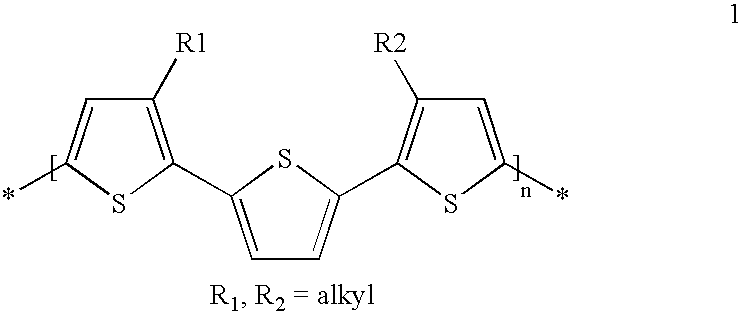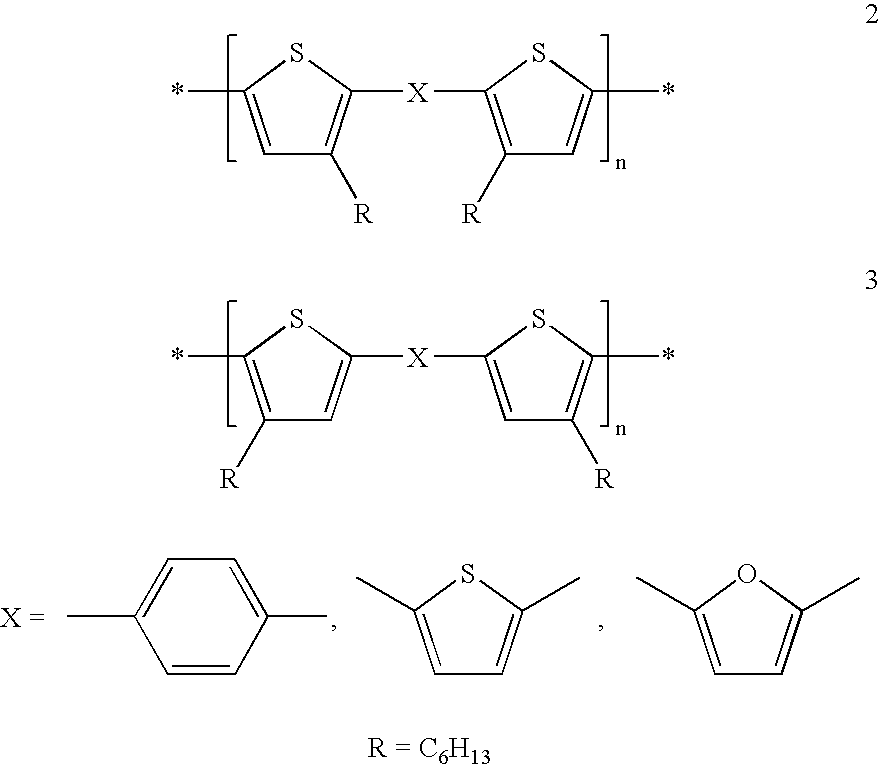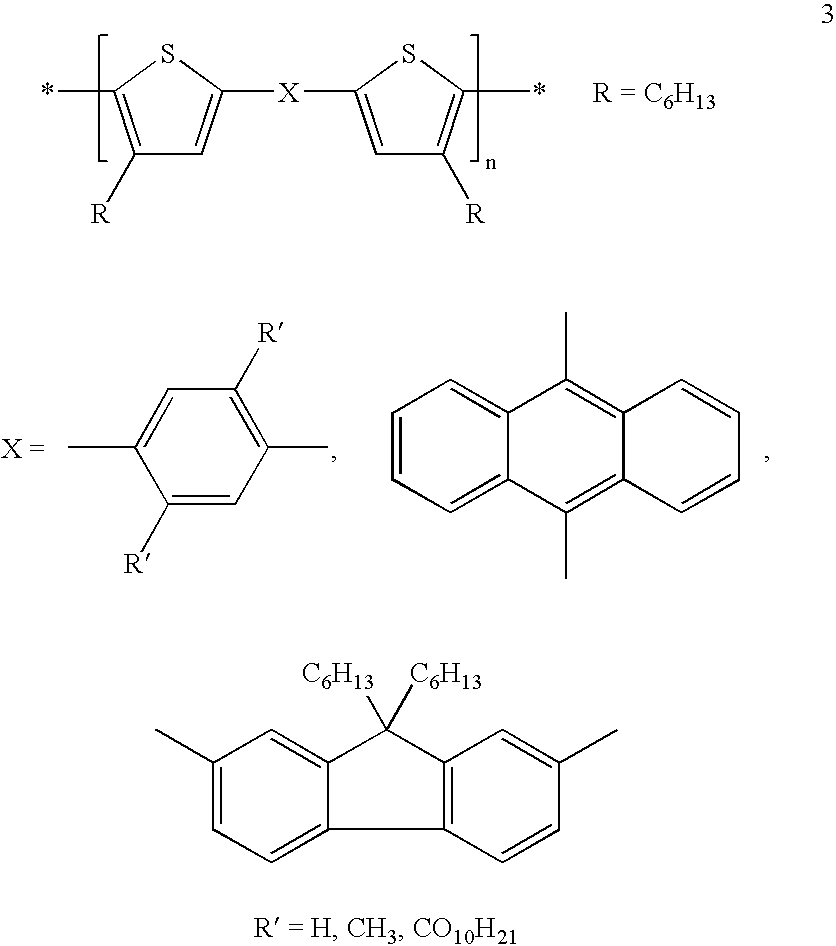Mono-, oligo- and poly-bis(thienyl) arylenes and their use as charge transport materials
a technology of thienyl arylene and oligo-arylene, which is applied in the direction of instruments, non-metal conductors, conductors, etc., can solve the problems of reduced device performance, low ionisation potential of poly(3-alkylthiophenes) and low ionisation potential of poly(3-alkylthiophenes)
Inactive Publication Date: 2004-06-24
MERCK PATENT GMBH
View PDF11 Cites 67 Cited by
- Summary
- Abstract
- Description
- Claims
- Application Information
AI Technical Summary
Benefits of technology
[0020] which has a thermotropic, nematic LC phase above 265.degree. C. and can be oriented into a monodomain state to give improved field effect mobility, and its use in a TFT.
[0022] A further aspect of the invention relates to reactive mesogens having a central core comprising a bis(thiophene) arylene unit, said core being linked, optionally via a spacer group, to one or two polymerisable groups. The reactive mesogens can induce or enhance liquid crystal phases or are liquid crystalline themselves. They can be oriented in their mesophase and the polymerisable group(s) can be polymerised or crosslinked in situ to form polymer films with a high degree of order, thus yielding improved semiconductor materials with high stability and high charge carrier mobility.
Problems solved by technology
In addition, it is important that the semiconducting material is relatively stable to oxidation, i.e., it has a high ionisation potential, as oxidation leads to reduced device performance.
However, vacuum deposition is an expensive processing technique that is unsuitable for the fabrication of large-area films.
However, poly(3-alkylthiophenes) have relatively low ionisation potentials and are susceptible to doping in air.
However, there have been no reports of the application of the above materials as semiconductors or charge transport materials.
This stacking allows intermolecular charge transport to occur more easily, leading to high charge carrier mobilities.
If SCLCPs are used in solutions, they can orient spontaneously when coated onto an appropriate surface and when at their mesophase temperature, which can result in large area, highly ordered domains.
Method used
the structure of the environmentally friendly knitted fabric provided by the present invention; figure 2 Flow chart of the yarn wrapping machine for environmentally friendly knitted fabrics and storage devices; image 3 Is the parameter map of the yarn covering machine
View moreImage
Smart Image Click on the blue labels to locate them in the text.
Smart ImageViewing Examples
Examples
Experimental program
Comparison scheme
Effect test
example 2
[0152] Polymer (18) was prepared as described below. 22
[0153] Dibromo naphthalene (16) was coupled to the Grignard reagent of 2-bromo, 3-hexylthiophene in the presence of a nickel catalyst to give the monomer (17). The monomer was polymerised by chemical oxidation using iron chloride to yield the polymer (18).
the structure of the environmentally friendly knitted fabric provided by the present invention; figure 2 Flow chart of the yarn wrapping machine for environmentally friendly knitted fabrics and storage devices; image 3 Is the parameter map of the yarn covering machine
Login to View More PUM
| Property | Measurement | Unit |
|---|---|---|
| carrier mobilities | aaaaa | aaaaa |
| charge transport | aaaaa | aaaaa |
| charge transport properties | aaaaa | aaaaa |
Login to View More
Abstract
Mono-, oligo- and poly-bis(thienyl) arylenes are suitable as as charge transport materials or semiconductors in electrooptical, electronic and electroluminescent devices, to charge transport and semiconductor materials, components and devices comprising mono-, oligo- and poly-bis(thienyl) arylenes.
Description
[0001] The invention relates to the use of mono-, oligo- and poly-bis(thienyl) arylenes as semiconductors or charge transport materials in electrooptical, electronic and electroluminescent devices. The invention further relates to semiconductor and charge transport materials, components and devices comprising mono-, oligo- and poly-bis(thienyl) arylenes. The invention relates to novel mono-, oligo-and poly-bis(thienyl) arylenes.BACKGROUND AND PRIOR ART[0002] Organic materials have recently shown promise as the active layer in organic based thin film transistors and organic field effect transistors [see H. E. Katz et al., Acc. Chem. Res., 2001, 34, 5, 359]. Such devices have potential applications in smart cards, security tags and the switching element in flat panel displays. Organic materials are envisaged to have substantial cost advantages over their silicon analogues if they can be deposited from solution, as this enables a fast, large-area fabrication route.[0003] The performanc...
Claims
the structure of the environmentally friendly knitted fabric provided by the present invention; figure 2 Flow chart of the yarn wrapping machine for environmentally friendly knitted fabrics and storage devices; image 3 Is the parameter map of the yarn covering machine
Login to View More Application Information
Patent Timeline
 Login to View More
Login to View More Patent Type & Authority Applications(United States)
IPC IPC(8): C07D333/18C07D333/28C08G61/12C09K19/34C09K19/38C09K19/58G03G5/06G03G5/07G11B7/244G11B7/245H01B1/12H01L29/786H10K99/00
CPCC08G61/126Y02E10/549C09K19/3804C09K19/582G03G5/0661G03G5/071G11B7/244G11B7/245H01B1/125H01B1/127H01B1/128H01L51/0036H01L51/0043H01L51/0052H01L51/0512C09K19/3491H10K85/113H10K85/151H10K85/615H10K10/462
Inventor HEENEY, MARTINGILES, MARKTIERNEY, STEVENMCCULLOCH, IAINBAILEY, CLARE
Owner MERCK PATENT GMBH
Features
- R&D
- Intellectual Property
- Life Sciences
- Materials
- Tech Scout
Why Patsnap Eureka
- Unparalleled Data Quality
- Higher Quality Content
- 60% Fewer Hallucinations
Social media
Patsnap Eureka Blog
Learn More Browse by: Latest US Patents, China's latest patents, Technical Efficacy Thesaurus, Application Domain, Technology Topic, Popular Technical Reports.
© 2025 PatSnap. All rights reserved.Legal|Privacy policy|Modern Slavery Act Transparency Statement|Sitemap|About US| Contact US: help@patsnap.com



